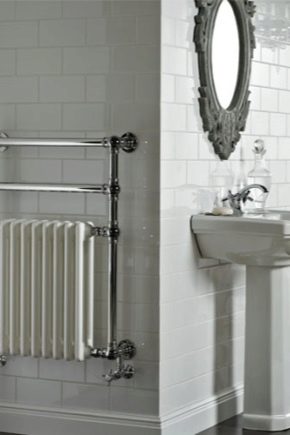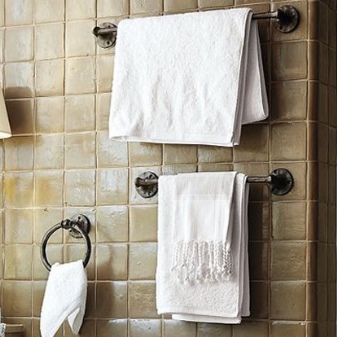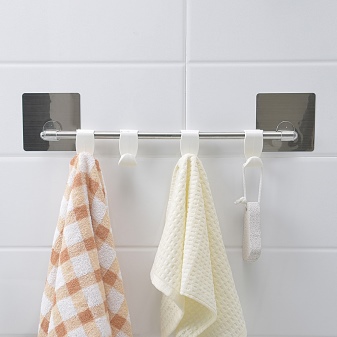Bathroom towel racks: how to choose and place?

Storage of towels is sometimes a problem. A towel holder, which includes a bar, rings, a stand, clamps and a stand, will help to solve it. The design can be very diverse. Today, a forged version is quite popular, which can be made by hand.


Peculiarities
There is a need for towels in any bathroom. To meet this need, you can use towel racks that differ in their shape and functionality, as well as in the type of placement and material of manufacture. In addition, such an attribute can complement the interior of the bathroom and emphasize the style of decoration.


Varieties
Towel accessories are divided according to various criteria: shape and location, material of manufacture and other qualities. The specificity of each type determines the operational and aesthetic features that are appropriate for solving functional tasks and fit into a specific interior.
Towel racks can be divided into several types.
- Hanger with hooks. A simple and economical option, it has many options. Such a device can be single, double, triple, etc. Often such hangers are attached to the wall using suction cups.


- Floor towel holder. Subtype of products with many options for execution - hooks, rungs or clips can be used as holders. They are made of both plastic and metal, by the size of the crossbars, they can hold either a whole towel, or dry the laundry rolled up. The plus is mobility - the hanger can be moved anywhere, minus - large dimensions. Accordingly, when using this type, the free space is reduced.
- Tubular hanger. The wall-mounted view of the product can consist of one or more tubes placed according to the "ladder" pattern, where each next crossbar is at a certain distance, which makes it possible for the laundry not to overlap and dry out faster. A relative disadvantage can be called a certain inconvenience when hanging towels, which decreases with the development of skills in its use.


- "Pinwheel". The main feature is the movable bars for optimal functionality and ease of use. Often wall-mounted, takes up a minimum of space, making it ideal for small bathrooms. In moments when the hanger is not in use, it can be folded by turning it towards the wall, thereby freeing up a certain area.
- Annular. More decorative than functional version of the product. A ring made of plastic or metal is placed on the wall, while the towel is in it in a crumpled state, so the drying rate is relatively low. It can be made in the form of a half-ring, square, oval and other geometric shapes.


- With a shelf. Combined model consisting of a shelf and hooks or tubes underneath. Some of the towels can be dried, and some dry ones can be folded on the shelf. This option is able to meet the needs of the whole family and at the same time is very compact.
- Classical. A heating or hot water pipe bent into a serpentine shape can not only dry clothes, but also serve as a towel rack. In this case, you may not need to install an additional towel rail.
- Desktop. A separate class of products. They are a structure with a varying number of small shelves in which rolled towels are stored. They are made of wood, metal, sometimes plastic, and have a wide range of colors and stylistic variations.



Materials (edit)
For the production of towel rails, metal and polymer materials are mainly used, although some models are made of wood, for example, table shelves. Each of them has positive and negative qualities that affect the further process of operation.

Polymer devices have the following advantages:
- relative cheapness;
- ease;
- a wide range of colors and shapes of products.
The disadvantages include:
- less durable;
- fragility;
- do not look so stylish and elegant.



Metal is a durable material with excellent qualities, but it must have a good quality coating that protects against corrosion.
Its positive characteristics include:
- durability;
- excellent appearance;
- practicality and convenience;
- solidity.
The disadvantages include:
- higher price;
- less extensive assortment of colors and models.



Criterias of choice
When choosing a towel holder, first of all, it is worth considering its operational features, as well as the appearance of the product, which also plays an important role.
To find the right product, it is worth taking into account a number of factors:
- the number of people who use the bathroom;
- space reserved for the product;
- indoor interior design;
- product specifications such as material of manufacture, etc.



For small spaces, ring and hook options are more suitable, while a floor towel holder and a product with a swivel mechanism can make it difficult to move freely. For medium-sized rooms, the best option would be a combined option, for example, a shelf with rings or a crossbar.
In terms of design, if the towel holder is purchased in a ready-made bathtub with a specific interior, the following options are possible:
- if the room is made in the "country" style, wood products (necessarily processed) with various hooks are suitable;
- a hanger made of brass or bronze will harmoniously fit into the classics;


- for modern styles, such as high-tech, a simple chrome-look product is suitable;
- renovation in a creative style is perfectly complemented by a towel holder of bright color and fancy shape. In this case, products made of polymer materials are just the right thing to do.
The fastening method also affects the aesthetic qualities of the towel holder. Products mounted on hidden fasteners, camouflaged with a cover plate, plugs or other elements, look neater and not striking.



Installation and placement
To secure the wall-mounted towel holder, you will need fasteners such as self-tapping screws or wall plugs.
Further, to install the product by an open method, you must do the following:
- drill holes in the towel holder with a drill or punch if they are not available;
- attach the product to the wall and mark the location of the fasteners along the drilled channels;
- drill holes in the wall according to the marks;
- install the supplied or selected separately fasteners in the holes;
- fix the product.

To turn the open method of fastening into a closed one, it is necessary to purchase special camouflage means, for example, plugs, covers, a masking panel, etc. The main difference between the methods is a more pleasant appearance in the closed type.
Suction cup holders can be an alternative for punch-through fastening., duct tape or double-sided tape. Installation of such elements is not difficult, you just need to press the corresponding part against the wall. However, in practice, this type of installation is poorly suited for massive bath towels, in addition to being wet. The high weight and high humidity of the room are too significant factors, which the strength of the suction cups and glue cannot block, as a result of which the holder often comes off the wall.
Vacuum suction cups can be called a quality replacement for a punching machine. Such a device has a considerable cost, but excellent reliability and integrity of the finish will compensate for this disadvantage. This type of fastening is suitable for smooth surfaces, for example, tiles, stone slabs, non-porous polymeric materials.


To install the suction cups, do the following:
- prepare the surface by thoroughly cleaning it from dirt and plaque, degrease and dry;
- after removing the protective film from the suction cup, press it tightly to the surface so that the silicone ring is in full contact with the wall;
- turn the special cap in the center of the product until it is completely fixed;
- check the quality of fastening - if the suction cup was installed correctly, and the cap is turned enough, then the job is done.
If the vacuum suction cup is installed incorrectly, it is necessary to remove the product by turning the cap in the opposite direction and repeat everything from the beginning. It is important to maintain the absolute cleanliness of the silicone surface providing vacuum. When reinstalling or contaminated, it is advisable to rinse it with water.


To install the floor model, you do not need any special conditions, you just need to choose a suitable place and unfold or assemble the towel holder according to the instructions.
When choosing a place where the hanger will be located, first of all, it is necessary to take into account the comfort when using the product and how this will affect the free space. Next, you need to estimate the required number of hooks or tubes. It is important that a pile does not form and the fabric does not melt and damp. You can arrange several hooks in some kind of fancy shape: flower, stairs, circle, cross, checkerboard, etc., and thus create a decorative element. In a large bathroom, it is possible to install several towel rails in different places, but made in the same style.


Self-production
You can use a variety of waste items to create a homemade towel holder. The most common option is to use a small ladder - a stepladder. The main thing is to treat the surface if it is made of wood. The product will perfectly fit into such design styles as kakeko, Scandinavian, Provence and retro.
Another option is to use a clothes hanger with a bar. In this case, you can hang the hanger on the pipe or make fasteners for it on the wall.
Another option is an old unnecessary curtain rod or curtain rod that can be shortened and covered with paint or varnish.



Tips & Tricks
In the process of choosing, installing and operating a towel holder, there are certain subtleties, following which you can improve certain points of operation. To prevent the towel from falling off the hooks, you can use special clips with eyelets at the end. The cost of such convenience is small, thanks to them, the linen does not fall on the floor and remains clean.
When choosing a towel holder, it is important to pay attention to the manufacturer. It so happens that a less durable plastic product, but of a good brand, lasts longer than a metal counterpart from a cheap segment. Low-quality metal begins to rust quickly, can easily deform, and the coating peels off.


The suction cup (not counting the vacuum) is suitable for lightweight polymer holders, on which one, maximum two small towels are hung. This option is possible with smooth walls, for example, tiles.
If necessary, hang several hooks in a row so as not to drill a separate hole for each hanger, you can use a special bracket on which all products are mounted. To install the bracket, you only need 2 drilled holes and a couple of self-tapping screws.
It is advisable to count hooks at least one per one family member, otherwise the towels hung together will take a long time to dry.

For small spaces it is convenient to use folding and sliding floor towel racks. When not in use, they can simply be folded and stowed away or pushed against the wall, freeing up space. Also, a corner shelf with hooks or a bar is perfect for a small bathroom. It takes up a minimum of space and at the same time gives the maximum effect.
Before installing the hangers, it is necessary to assess the growth of the tenants so that everyone can reach their own towel. For a child, you can make a towel holder on a separate low mount.


For information on how to install the towel holder, see the next video.













The comment was sent successfully.